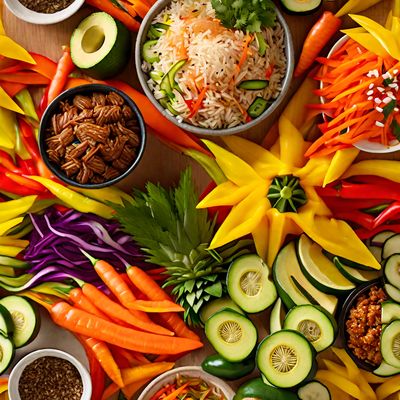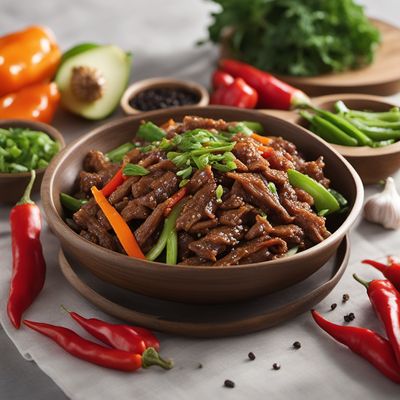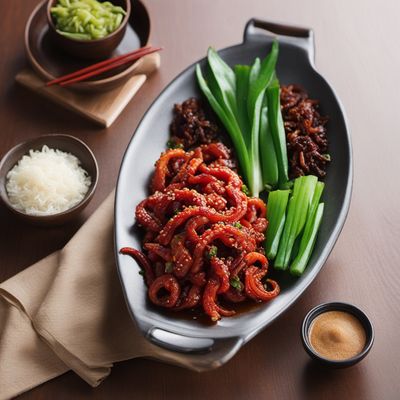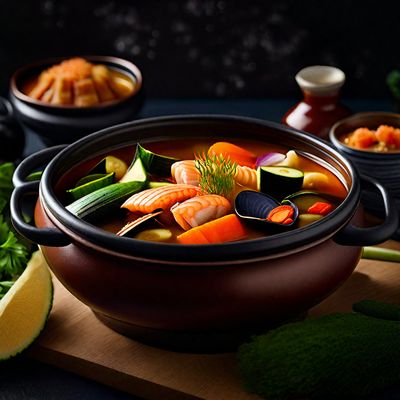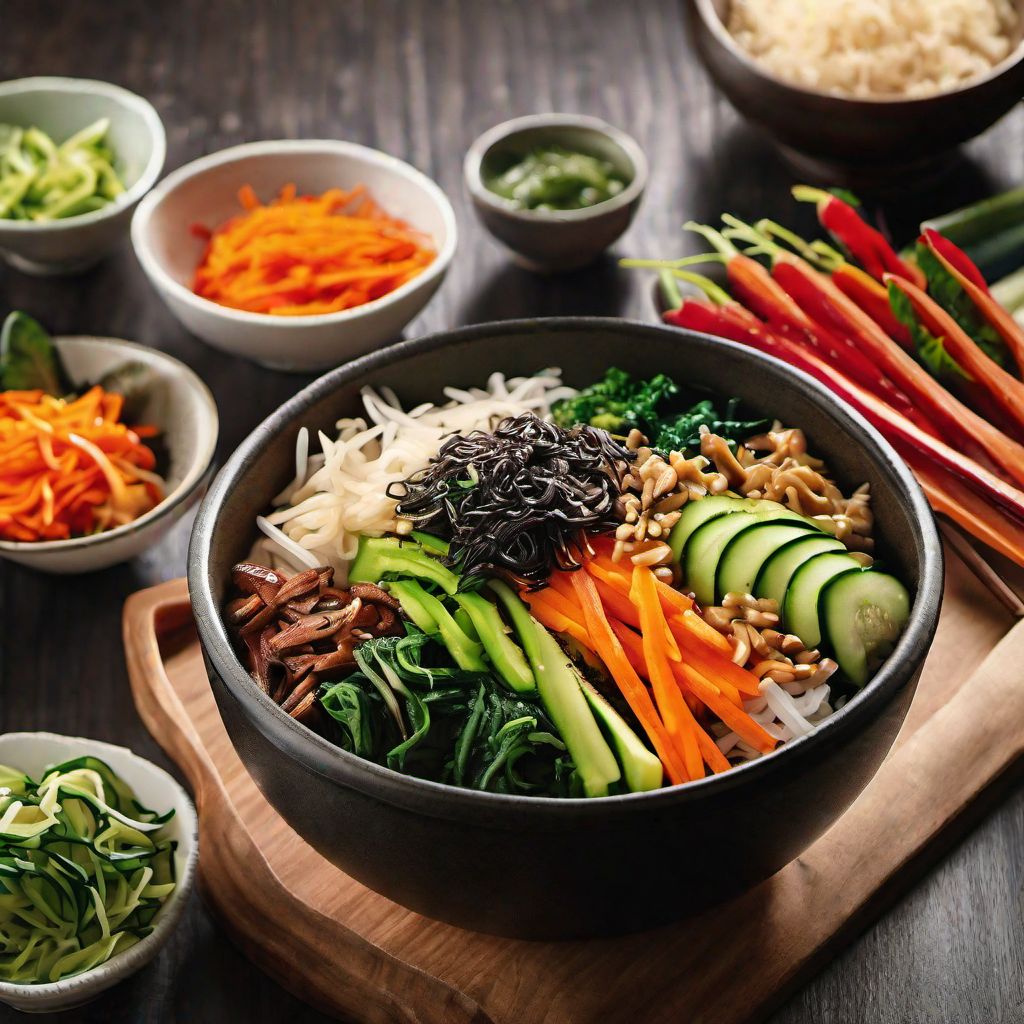
Recipe
Vegetarian Bibimbap
Vibrant Veggie Delight: Vegetarian Bibimbap
5.0 out of 5
In the realm of vegetarian cuisine, Vegetarian Bibimbap is a delightful adaptation of the traditional Korean dish. Bursting with colors and flavors, this plant-based version offers a nutritious and satisfying meal. Packed with fresh vegetables, rice, and a savory sauce, Vegetarian Bibimbap is a perfect choice for those seeking a meatless option without compromising on taste.
Metadata
Preparation time
20 minutes
Cooking time
10 minutes
Total time
30 minutes
Yields
4 servings
Preparation difficulty
Easy
Suitable for
Vegetarian, Vegan, Gluten-free, Dairy-free, Nut-free
Allergens
Soy
Not suitable for
Meat-based diets, Paleo diet, Ketogenic diet, Low-carb diet, High-protein diet
Ingredients
The original Bibimbap typically includes meat, such as beef or pork, along with a fried egg. In this vegetarian adaptation, the meat is replaced with a variety of colorful vegetables, making it suitable for vegetarians. Additionally, the fried egg is omitted or substituted with a vegan alternative, ensuring that this dish remains entirely plant-based. We alse have the original recipe for Bibimbap, so you can check it out.
-
2 cups (470ml) cooked rice 2 cups (470ml) cooked rice
-
1 cup (150g) julienned carrots 1 cup (150g) julienned carrots
-
1 cup (150g) julienned zucchini 1 cup (150g) julienned zucchini
-
1 cup (150g) bean sprouts 1 cup (150g) bean sprouts
-
1 cup (150g) sliced mushrooms 1 cup (150g) sliced mushrooms
-
1 cup (150g) spinach 1 cup (150g) spinach
-
1 tablespoon vegetable oil 1 tablespoon vegetable oil
-
2 cloves garlic, minced 2 cloves garlic, minced
-
2 tablespoons soy sauce 2 tablespoons soy sauce
-
1 tablespoon sesame oil 1 tablespoon sesame oil
-
1 tablespoon gochujang (Korean chili paste) 1 tablespoon gochujang (Korean chili paste)
-
1 tablespoon rice vinegar 1 tablespoon rice vinegar
-
Salt, to taste Salt, to taste
-
Sesame seeds, for garnish Sesame seeds, for garnish
-
Sliced green onions, for garnish Sliced green onions, for garnish
Nutrition
- Calories (kcal / KJ): 350 kcal / 1465 KJ
- Fat (total, saturated): 8g, 1g
- Carbohydrates (total, sugars): 62g, 6g
- Protein: 9g
- Fiber: 6g
- Salt: 2g
Preparation
-
1.In a large skillet, heat the vegetable oil over medium heat. Add the minced garlic and sauté for 1 minute.
-
2.Add the carrots, zucchini, bean sprouts, and mushrooms to the skillet. Stir-fry for 3-4 minutes until the vegetables are tender-crisp. Season with salt to taste.
-
3.In a separate pot, blanch the spinach in boiling water for 1 minute. Drain and rinse with cold water. Squeeze out any excess water and set aside.
-
4.In a small bowl, whisk together the soy sauce, sesame oil, gochujang, and rice vinegar to make the sauce.
-
5.Divide the cooked rice among serving bowls. Arrange the sautéed vegetables and blanched spinach on top of the rice.
-
6.Drizzle the sauce over the vegetables and rice. Garnish with sesame seeds and sliced green onions.
Treat your ingredients with care...
- Carrots — To achieve the perfect julienne, use a sharp knife or a julienne peeler.
- Bean sprouts — Blanch the bean sprouts in boiling water for 1-2 minutes to retain their crunchiness.
- Gochujang — Adjust the amount of gochujang according to your spice preference. Add more for a spicier bibimbap.
- Rice — Use cooked rice that has been cooled down slightly for best results. Cold rice works well for bibimbap.
Tips & Tricks
- Substitute any vegetables with your favorites or what's in season.
- For a protein boost, add marinated tofu or tempeh to the bibimbap.
- Customize the spiciness by adjusting the amount of gochujang.
- Top with a fried egg or a vegan egg substitute for added richness.
- Serve with a side of kimchi for an authentic Korean experience.
Serving advice
Serve the Vegetarian Bibimbap hot, allowing the flavors to meld together. Mix all the ingredients thoroughly before enjoying to ensure each bite is a harmonious blend of textures and tastes.
Presentation advice
For an eye-catching presentation, arrange the colorful vegetables in separate sections on top of the rice. Sprinkle sesame seeds and sliced green onions on top for an added pop of color and freshness.
More recipes...
For Bibimbap » Browse all
For Korean cuisine » Browse all
More Korean cuisine dishes » Browse all
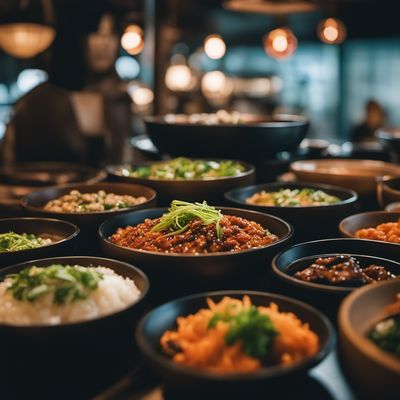
Banchan
Banchan is a Korean term for a variety of small dishes served as side dishes with rice and soup. These dishes are meant to be shared and are an...
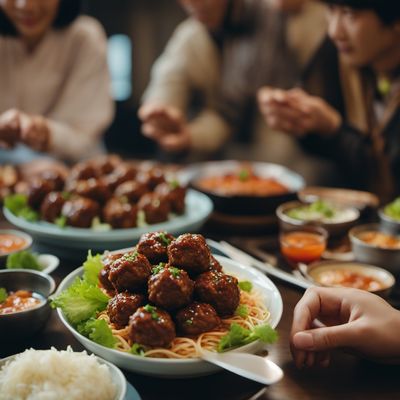
Wanjajeon
Korean meatballs
Wanjajeon is a traditional Korean dish that is made with pan-fried meatballs. The dish is typically served as an appetizer or as a main course...

Sundaeguk
Korean sausage soup
Sundaeguk is a Korean soup made with blood sausage and vegetables. It is a hearty and flavorful dish that is perfect for cold weather.


